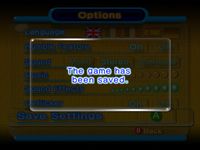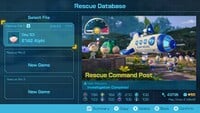Saved game
|
The following article or section is in need of assistance from someone who plays Pikmin 3. |
A saved game (also known as a save game or simply save) is a record on the progress a player has made on a game thus far, which allows them to stop playing and later return to the point whence they left off. In the first two Pikmin games, there are two types of information saved: a trio of playthrough progress slots and the global progress data. In Pikmin 3, there is only one playthrough slot in a Wii U user account, however, in Pikmin 3 Deluxe, 3 save file slots were added to Story Mode.
The playthrough progress is a record that contains the progress made in the main adventure mode. This includes information such as the current day, the number of Pikmin of each type, and the collected ship parts, treasures, fruits, and/or castaways. In every game except the original Wii U release of Pikmin 3, up to three individual records may be kept, allowing three different players to keep their own progress through the main adventure mode. These records can be deleted or copied from one slot to another.
The global progress contains data about the progress of the game's content outside of the main story mode. As such, this record is updated regardless of which story mode slot is used, and for extra game modes such as Challenge Mode, that do not have a specific playthrough slot attached. Examples of the information saved in this record are the high scores, Challenge Mode completion and records, unlocked bonuses and the settings in the options menu.
In Hey! Pikmin, there again can be up to 3 different saved games at a time. However, since there are no alternative game modes, the only global data that gets saved is the settings in the options menu.
Persistence[edit]
In order for this information to be persistently saved between system boots, it must be stored somewhere. This location depends on the system. For the GameCube original games, the information must be stored in a memory card. The Pikmin games only read and write to the memory card in slot A. If a memory card cannot be used when the game needs to load or save, it will display a warning notifying the player that the memory card is invalid; it will also specify the exact reason of the error, be it because the memory card is full, corrupted, or even absent altogether. If these GameCube games are played on a Wii console, the same rules still apply. All information takes on the form of a single file of data inside the memory card, meaning the three playthrough progresses and the global progress are kept in the same place. These save files can be managed on the GameCube's system menu, by copying or moving the files between memory cards, or deleting them completely. The saved data in Pikmin is worth 19 blocks on the memory card, and the one in Pikmin 2 is worth 27.
The Wii-exclusive games, the ones in the New Play Control! line, save their progress inside the Wii's persistent NAND flash memory, known as the Wii System Memory. Much like the memory card system on the GameCube, the games only access the saved games inside the Wii, and not those inside an SD card. The saved games can however be copied or moved between the Wii and an SD card, or deleted altogether. The same type of warnings will also appear if the game cannot read or write the saved games. Like the GameCube games, the saved game data is kept entirely in a single file. New Play Control! Pikmin's saved data requires 31 blocks on the Wii's system memory, and New Play Control! Pikmin 2 requires 2 blocks.
Saving[edit]

In the first two Pikmin games, whenever the game needs to be saved, a prompt appears asking the player if they wish to save the game; exceptions exist, detailed below. The player has the option to refuse the save operation – this is useful should the player have a bad day and not wish to keep it; the player can refuse the save and return to the saved game selection menu in order to re-load their progress and try again. Interestingly, the games also ask the player if they can save a new score at the end of a Challenge Mode level.
Saves are done at the following times:
- When a new file is created on memory card A or the Wii's internal storage.
- At the end of a day.
- When leaving a cave.
- At the end of the main story mode.
- When a Challenge Mode or Mission Mode level is completed.
- When changing the options.
The only times a game saves without asking in the first two games, are in Pikmin, when the options are changed, and in Pikmin 2, when a player enters a cave or sublevel. The exact reason for the latter is unknown, but it could be related to the cave's random method of generation not always delivering a fair layout. This allows the players to reset the console and retry the same sublevel with a different layout, as opposed to restarting the entire day. Because having the game ask to save at each sublevel would become annoying to the player, the save was made automatic. An unused setting inside the game's files makes the game ask each time, instead of saving automatically. The automatic saving can be bypassed by removing the memory card in slot A on the GameCube games, at which point the game will warn that it could not save, and give the player the option to continue without saving. As a result, this method is not possible in the New Play Control! and Nintendo Switch versions. In Pikmin 2, going through the messages that appear when the memory card is absent is faster than waiting for the game to save.[1]
In Pikmin 3 and Pikmin 4, the game will no longer prompt the player to save their progress, opting for an autosave system instead. In Pikmin 3, the game will open a message box when progress has been saved, which then can be closed. Pikmin 4, however, does not show indication of completion of an autosave other than the autosave icon on the top left of the screen being absent.
Saved content[edit]
The following is a list of the content that gets saved persistently.
Pikmin[edit]
These bits of information get saved for each playthrough:
- Current day number.
- The ID of each voyage log entry, on each day.
- Area visited in the previous day.
- Number of leaf, bud and flower Pikmin of each type, inside Onions.
- Location, collection status and "discovery" status of ship parts.
- Status of the Yellow and Blue Onions.
- Location, type and maturity of buried Pikmin.
- Death information of enemies, so that the game knows when to respawn them.
- The progress on bridges, gates, etc.
- Total number of Pikmin killed, left behind, and born.
- Whether Pikmin have experienced nectar, grabbed bomb-rocks, etc. These are used for the monologs.
All points besides the first two are also saved on a per-day basis in New Play Control! Pikmin; this allows the player to go back and retry a previous day.
The following data gets saved globally:
- High scores, including Challenge Mode scores.
- Option settings.
Pikmin 2[edit]
Pikmin 2 saves the following information for each playthrough:
- Current day number.
- Area visited on the previous day.
- Number of leaf, bud and flower Pikmin of each type, inside Onions.
- Number of sprays and berries.
- Number of collected Pokos.
- Location and collection status of treasures.
- Whether Purple, White, Yellow and Blue Pikmin have been discovered.
- New Treasure Hoard and Piklopedia entries.
- Total of enemies killed and Pikmin lost, for each Piklopedia enemy.
- Location, type and maturity of buried Pikmin.
- Death information of enemies, so that the game knows when to respawn them.
- The progress on bridges, gates, etc.
- Total number of Pikmin killed, for each method.
- Whether Pikmin have experienced nectar, set on fire, etc. These are used for the ship's dialogs.
- The IDs of the 20 most recent mails.
- If the save happened when entering a sublevel:
- Number of Pikmin of each maturity in the party.
- Sublevel and cave.
- Treasures salvaged in the trip.
- Number of Pikmin killed in the trip.
- Number of Pokos obtained in the trip.
- Time of day.
- Active leader.
- If the save happened after leaving a cave:
- Area in which the cave is.
- Number of Pikmin of each maturity in the party.
- Time of day.
The following information is saved globally:
- Challenge Mode high scores, for both single-player and two-player, and whether a perfect run happened or not.
- High scores.
- Option settings.
- Unlocked bonuses.
- Last Challenge Mode level's status (if the game was exited after a level was completed with a perfect ranking, the next time the game is booted and the Challenge Mode screen accessed, that level's leaf/white flower will be seen turning into a pink flower).
- If the Titan Dweevil has ever been defeated. If so, the Piklopedia will be able to show Louie's notes.
Pikmin 3[edit]
The game saves the following information:
- For each day:
- Area visited on the previous day.
- Which story mode events have been triggered, like spotting the Winged Onion, defeating a boss, etc.
- Number of leaf, bud and flower Pikmin of each type, inside the Onion.
- Number of sprays and berries.
- Color of every full bottle of juice.
- Color and amount of juice on the next bottle.
- Location and collection status of fruits.
- Whether Rock, Yellow, Winged and Blue Pikmin have been discovered.
- What data files have been collected.
- Total of Pikmin lost.
- Location, type and maturity of buried Pikmin.
- Death information of enemies, so that the game knows when to respawn them.
- The progress on bridges, gates, etc.
- Whether Pikmin have experienced nectar, set on fire, etc.
- The ID of that day's log entry.
- The charted parts of the map on the radar, for every area. This record remains even when going into previous days, and is only reset if the adventure is restarted from day 1.
- The full Secret File code for the current playthrough. This too is only reset if the story is restarted from day 1.
- Last control scheme used.
- Top 5 story mode completion stats.
- Top 5 scores for every mission, both single player and 2-player.
- Unlocked Bingo Battle stages.
- Unlocked Bingo Battle stage layouts, or alternatively, the number of battles completed in each stage.
Metadata[edit]
- Pikmin
- Size: 19 blocks
- Pikmin 2
- Size: 27 blocks
- New Play Control! Pikmin
- Size: 31 blocks
- Save blurb: “Pikmin are alive!”
- New Play Control! Pikmin 2
- Size: 2 blocks
- Save blurb: “To me, Pikmin!”
- Pikmin 1 (Nintendo Switch)
- Size: 1.09 GB
- Pikmin 2 (Nintendo Switch)
- Size: 1.04 GB
- Pikmin 1+2
- Size: 2.13 GB
- Pikmin 3
- Size:
- Save data: 29 MB (per save)
- Shared save data: 1536 KB
- Downloadable content: 530 MB (when all DLC packs are bought)
- Update data: 356 MB
- Size:
- Pikmin 3 Deluxe
- Size: 6.5 GB (Digital)
- Pikmin 4
- Size: 10.5 GB (Digital)
- Hey! Pikmin
- Size: 3,222 blocks
- Pikmin Bloom
- Size: 268.7 MB
Corruptions[edit]
It is possible for saved games to become corrupt. The reasons for this are not well known. Sometimes, the data can actually be repaired, but other times, it is too corrupted to be recovered, leaving the player with no option but to clear the save data and start from scratch. There are reports of Pikmin save files becoming corrupt, and the game's attempts at repairing them leading to incorrect data.[2][3][4] Effects include area objects in the wrong spots, and insane Pikmin, day, and ship part counts.
Naming[edit]
Inside the games, no name is given for the concept of a record of persistent information. The playthrough progress slots are however given an identification in Pikmin and Pikmin 2. On the saved game selection menu in Pikmin, a message at the top says "Choose a Data File", and on the bottom-right, as well as on the day results menu, the playthrough progress slot is given the name "Ship's Log", followed by the respective slot number. Pikmin 2 also calls these slots "Ship's Log", but never "Data File". In addition, because there is only one slot in Pikmin 3, the concept of a slot does not exist. To make matters more confusing, Pikmin 3 introduced gameplay objects known as data files.
Because of the lack of consensus between the games, and because of the ambiguity that could've stemmed from the name "data file", it was decided that, on the wiki, the concept of a record of progress in the games would be known as a "saved game", especially given that it is the most well-known term in the video game industry.
Gallery[edit]
The saved game selection menu in Pikmin.
Trivia[edit]
- Games can read saved game data from different games. In Super Smash Bros. Melee, if the player has a saved game for Pikmin in the same memory card, they will be given the Captain Olimar trophy.
See also[edit]
External links[edit]
References[edit]
- ^ YouTube video comparing the time it takes between saving and not saving in Pikmin 2
- ^ YouTube video of a corrupt Pikmin saved game
- ^ YouTube video of a corrupt Pikmin saved game
- ^ YouTube video of a corrupt Pikmin saved game


